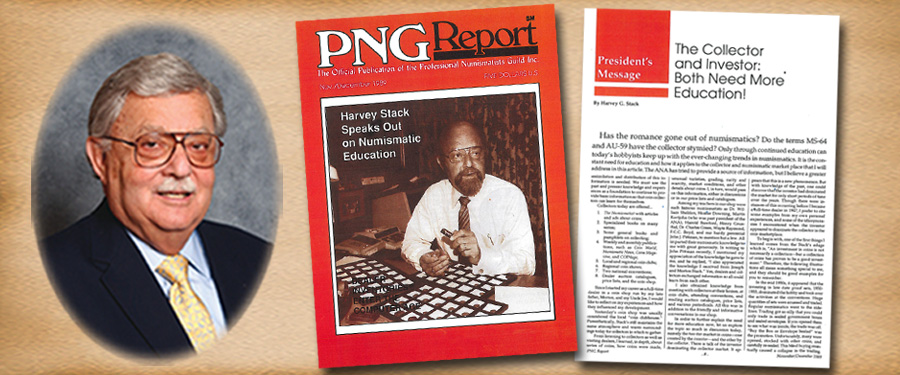
This week I continue with my President’s Message from the November/December 1989 copy of the PNG Report about the need for education in numismatics. As 1989 was early in the days of third-party grade, it is interesting to read this now that “slabbing” has been going on for more than a quarter of a century.
Another matter must be mentioned at this time, which further emphasizes the need for more information to be put into the hands of the collectors, dealers and grading services.
Recently, there have been a large number of quite lovely coins returned by the services described as cleaned — cannot be graded. The limitations imposed by using the two letters MS, followed by two numbers, such as 64 for example, restrict the major services in describing a coin numismatically. This abbreviated type of grading developed for commercial expediency provides no opportunity for variations within a grade number. The system, therefore, does not make it easy for the collector to make a numismatic decision about any coin being offered to him.
Coins are really like individuals. They differ subtly one from the other. Each is the product of their manufacture and their subsequent environment.
One only has to look back 25 to 50 years ago, or even 200 years ago, and realize that the earlier collectors could not keep their coins in a vacuum or in a sterile state. Coins were stored in wooden trays and cabinets, with sulfites sometimes in the wood or glue. Dangerous chemicals were also found in card boxes, paper envelopes, or in Wayte Raymond loose-leaf album pages. Even cellophane envelopes dried, cracked, and caused coins to tone and tarnish. Later poly bags were found to emit P.V.C.
In an attempt to preserve the coins for future generations, sometimes chemicals (advocated for decades by advanced and astute collectors) were used to remove any sulfites from coin surfaces. Even Dr. Sheldon suggested special oils and mild brushing to preserve the delicate copper coins. For at least the past 50 years, chemicals were advertised in numerous trade publications as a preventative to the damage caused by corroding agents. The intent was to preserve, not destroy the coins. Please don’t misinterpret these comments to include polishing with an abrasive, buffing, whizzing, or any other form of harsh cleaning.
And it should also be remembered that many coins acquired unusual colors, toning, and sometimes an uncommon appearance because of the environment in which they were stored without ever being touched by any chemical. For example, a coin stored in a wooden cabinet, face up, could be dark blue on the obverse, and silver white on the reverse. This was not cleaned! But some services have in many cases said so arbitrarily.
ANACS has tried to resolve this problem for the collector. For those coins, which they are not able to grade because a qualification or further description may be required, ANACS does not slab them, but provides a photo certificate, which has room for a more extensive description. This is the service the collector and investor deserves rather than being shut out completely. This policy must be maintained by ANACS, and should be followed by the other services.
I believe it is incumbent on the ANA to encourage a forum between the various grading services to develop a greater uniformity and standardization in assigning grades to coins. Collectors years ago were dependent on their own judgment for grading, developed from their own experience. Grading is unquestionably an art and a grade is established in the eyes of the beholder.
As a recent letter to the editor of Coin World indicates, something must be done when a coin submitted nine times to both major services comes back as an MS-64. When it was submitted for a 10th time, it came back as an MS-65. This suggests it had improved with time! However, the value for a one-grade difference changes from $5,000 to $50,000. This example proves the need for more unanimity between the services. I have also seen the reverse occur. In three submissions to the same service, another coin dropped from MS-64 to 63 and finally to 62.
We must develop more programs to teach collectors and investors self grading within certain established guidelines, so that the final decision as to what they acquire is their own, and it is in concert with standards that all are willing to accept.
(Continued next week)





